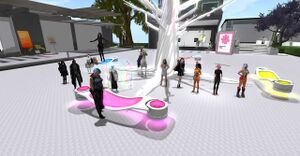Course:FNIS454/Indigenous Survivance and Sovereignty in Video Games
| FNIS 454 Indigenous New Media | |
|---|---|

| |
| About this Resource | |
| This open access resource is developed by the students of FNIS 454: Indigenous New Media. Via summary and analysis of key article, this wiki explores the theoretical, cultural, socio-political, and gendered dynamics underwriting the histories and futures of Indigenous new media as it develops out of the late 90s and into the present moment. | |
| Index | |
| |
Lagace's Indigenous Video Game Media Thesis
Indigenous Representations and the Impacts of Video Games Media on Indigenous Identity[1]
Naithan Lagace’s Indigenous Representations and the Impacts of Video Games Media on Indigenous Identity offers insights to the racist history of video games, where it is at today, and constructs a space for which video games can honour the ongoing survivance and sovereignty of Indigenous peoples. Lagace begins his work with an analysis of several historical and negative representations of Indigenous peoples in New Media. As Lagace introduces through Cornel Pewewardy’s work, “...manufactured reality is one of the most powerful shackles subjecting Indigenous peoples. It distorts all indigenous experiences, past and present”.[2] Lagace introduces his work with the creation of the website Indigitalgames.com, blogging about many representations of Indigenous peoples in Videogame media; negative and positive. Virtually since inception, video games have most often reinforced harmful tropes surrounding Indigenous peoples.
Negative Representations in Video Game Media
At the beginning of Chapter 2, 'Complexities of Representations and Simulations in Digital Media', Lagace asserts that, "Virtually since inception, video games have most often reinforced harmful tropes surrounding Indigenous peoples".[3] Throughout Chapter 2, Lagace exposes historical representations and complexities of negative representations of Indigenous peoples in Digital Media; overviewed and analyzed in the referenced Mad Dog 2: The Lost Gold, Westerado, Until Dawn, and Assassins Creed 3. Simultaneously, Lagace provides a significant critique to these tropes/stereotypes. This chapter is saliently concerned with how media representations of Indigenous men reflects into their communities, repressing all peoples there as a whole. Lagace does some boasting of Assassins Creed 3, but, ultimately, knows that it is a troubling representation of Indigenous men and masculinities (hyper-masculinity) when the communities have a real need for better role models and healthier masculinities.
Decolonizing Indigenous Video Game Media
Never Alone also becomes a shining model of Indigenous survivance and sovereignty to Lagace who says, "Creating ethical representations of Indigenous culture is done in multiple ways. One example of ethical storytelling within Never Alone is through the creation of the characters themselves".[4] Upper One Games, developer of Never Alone, develops a game centred around an example of that change "through the addition of a female character Nuna. Female characters were underrepresented in video games and have been mainly “hyper-sexualized” through the decades of Indian representations within video games".[4] This character demonstrates how Indigenous pedagogies can intervene into and the deconstruction of oppressive power dynamics, both simulated and in reality; replacing what is told, in Inupiaq teaching, as a young male character into a young female character. This article also reviews how Indigenous video game media company AbTec intervened into the Assassins Creed 3 writing to create more positive representations. Lagace also reminds us, “video games continue to produce opportunities for Indigenous communities at large”.[5] Closing up his article, we are redirected to models of action and success in the decolonization of Video Game Media, uplifted and actualized by projects/organizations such as AbTec, Skins, Placeholder, and SimPa. Through the process Lagace provides, put into action, what was once a space of manufactured oppression becomes a space of liberation.
References
- ↑ Lagace, Naithan. Indigenous Representations and the Impacts of Video Games Media on Indigenous Identity, 2018. University of Manitoba Library, http://hdl.handle.net/1993/33700. Accessed 01 May 2021.
- ↑ Lagace, Naithan. Indigenous Representations and the Impacts of Video Games Media on Indigenous Identity, 2018, p. 8. University of Manitoba Library, http://hdl.handle.net/1993/33700. Accessed 01 May 2021.
- ↑ Lagace, Naithan. Indigenous Representations and the Impacts of Video Games Media on Indigenous Identity, 2018, p. 32. University of Manitoba Library, http://hdl.handle.net/1993/33700. Accessed 01 May 2021.
- ↑ 4.0 4.1 Lagace, Naithan. Indigenous Representations and the Impacts of Video Games Media on Indigenous Identity, 2018, p. 66. University of Manitoba Library, http://hdl.handle.net/1993/33700. Accessed 01 May 2021.
- ↑ Lagace, Naithan. Indigenous Representations and the Impacts of Video Games Media on Indigenous Identity, 2018, p. 18. University of Manitoba Library, http://hdl.handle.net/1993/33700. Accessed 01 May 2021.
